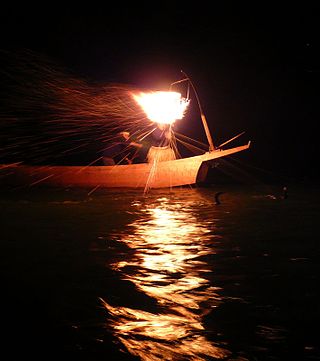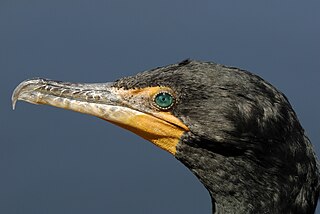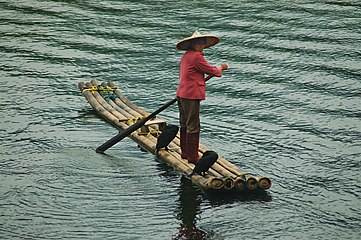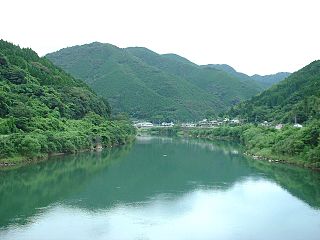
Gifu Prefecture is a prefecture of Japan located in the Chūbu region of Honshu. Gifu Prefecture has a population of 1,991,390 and has a geographic area of 10,621 square kilometres (4,101 sq mi). Gifu Prefecture borders Toyama Prefecture to the north; Ishikawa Prefecture to the northwest, Fukui Prefecture and Shiga Prefecture to the west, Mie Prefecture to the southwest, Aichi Prefecture to the south, and Nagano Prefecture to the east.

Phalacrocoracidae is a family of approximately 40 species of aquatic birds commonly known as cormorants and shags. Several different classifications of the family have been proposed, but in 2021 the International Ornithologists' Union (IOU) adopted a consensus taxonomy of seven genera. The great cormorant and the common shag are the only two species of the family commonly encountered in Britain and Ireland and "cormorant" and "shag" appellations have been later assigned to different species in the family somewhat haphazardly.

The great cormorant, known as the black shag or kawau in New Zealand, formerly also known as the great black cormorant across the Northern Hemisphere, the black cormorant in Australia, and the large cormorant in India, is a widespread member of the cormorant family of seabirds. The genus name is Latinised Ancient Greek, from φαλακρός and κόραξ, and carbo is Latin for "charcoal".

Seki is a city located in Gifu, Japan. As of 1 January 2019, the city had an estimated population of 89,020 and a population density of 190 persons per km2 in 35,366 households. The total area of the city was 472.33 square kilometres (182.37 sq mi).

Gujō is a city located in Gifu, Japan. As of 1 February 2019, the city had an estimated population of 41,858, and a population density of 41 persons per km2, in 15,341 households. The total area of the city was 851.21 square kilometres (328.65 sq mi). Gujo Hachiman, a part of the city that was an independent town until 2004, and has a large summer bon odori festival, Gujo Odori.

Erhai or Er Lake, is an alpine fault lake in Dali City, Dali Prefecture, Yunnan province, China. Erhai was also known as Yeyuze (叶榆泽) or Kunming Lake (昆明池) in ancient times.
The ayu sweetfish, ayu or sweetfish, is a species of fish. It is the only species in the genus Plecoglossus and family Plecoglossidae. It is a relative of the smelts and other fish in the order Osmeriformes.

The Japanese cormorant, also known as Temminck's cormorant, is a cormorant native to the east Palearctic. The species occur from Taiwan, northwards through Korea and Japan, to the Russian Far East.

The Nagara River has its source in the city of Gujō, Gifu Prefecture, and its mouth in the city of Kuwana, Mie Prefecture, Japan. Along with the Kiso River and Ibi River, the Nagara River is one of the Kiso Three Rivers of the Nōbi Plain. Previously, the river was named Sunomata River. With a length of 166 km (103 mi), it drains an area of 1,985 square kilometres (766 sq mi) in the Chūbu region and empties into Ise Bay. The government of Japan classifies it as a Class 1 river.

Gifu is a city located in the south-central portion of Gifu Prefecture, Japan, and serves as the prefectural capital. The city has played an important role in Japan's history because of its location in the middle of the country. During the Sengoku period, various warlords, including Oda Nobunaga, used the area as a base in an attempt to unify and control Japan. Gifu continued to flourish even after Japan's unification as both an important shukuba along the Edo period Nakasendō and, later, as one of Japan's fashion centers. It has been designated a core city by the national government.

Cormorant fishing on the Nagara River has played a vital role in the history of the city of Gifu, Gifu Prefecture, Japan. Throughout its long history, it evolved from a means to live, to a profitable industry, to a major tourist draw. It runs from May 11 to October 15 of each year.

Gōdo-juku was the fifty-fourth of the sixty-nine stations of the Nakasendō connecting Edo with Kyoto in Edo period Japan. It is located in former Mino Province in what is now part of the city of Gifu, Gifu Prefecture, Japan.

The Cormorant Fishing House is a museum dedicated to Cormorant Fishing on the Nagara River and located in the city of Gifu, Gifu Prefecture, Japan. In addition to viewing artifacts from the history of cormorant fishing, visitors can also view the cormorants actually used in the process. The museum is run by the cormorant fishing masters, who are Imperial Agents of the Imperial Household Agency.

The Nagaragawa Onsen are a group of onsen located along the banks of the Nagara River in Gifu, Gifu Prefecture, Japan. The source of the onsen are in the northern part of the city near the Mitabora Shinbutsu Onsen (三田洞神仏温泉). The group was included on the 16th edition of Japan's Top 100 Onsen.

Gifu Gokoku Shrine is a Shinto shrine located at the base of Mount Kinka in Gifu, Gifu Prefecture, Japan. The shrine is dedicated to the 37,000 residents of Gifu Prefecture who have died in wars since the Meiji Restoration. Official ceremonies are also held at the neighboring Hotel Seiran, which is part of the shrine facilities.

China has one-fifth of the world's population and accounts for one-third of the world's reported fish production as well as two-thirds of the world's reported aquaculture production. It is also a major importer of seafood and the country's seafood market is estimated to grow to a market size worth US$53.5 Billion by 2027.

The Gōnokawa River is a river that runs through Hiroshima and Shimane prefectures in Japan. It is the largest river in the Chūgoku region. It is also called the Gōgawa River and, in Hiroshima, the Enokawa River.

Cormorant culling is the intentional killing of cormorants by humans for the purposes of wildlife management. It has been practiced for centuries, with supporters of culling generally arising from the angling community. Culling techniques may involve the killing of birds, the destruction of eggs, or both. Historically, culls have occurred to protect the interests of recreational and commercial fishermen who perceive the animals to be competing with them for their intended catch or for the prey of their intended catch. Since the 1960s, the growing aquaculture industry has undertaken cormorant culls to protect its farmed fish and crustacean stocks. Opponents of cormorant culling include conservation groups such as the National Audubon Society, Cormorant Defenders International and Sea Shepherd.
Ukai is a Noh play of around 1400, attributed to Enami no Sayemon.
































